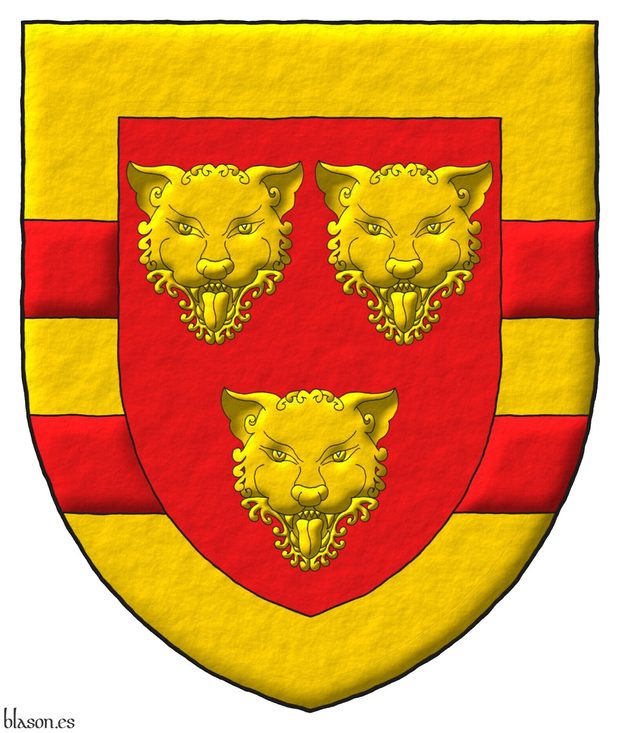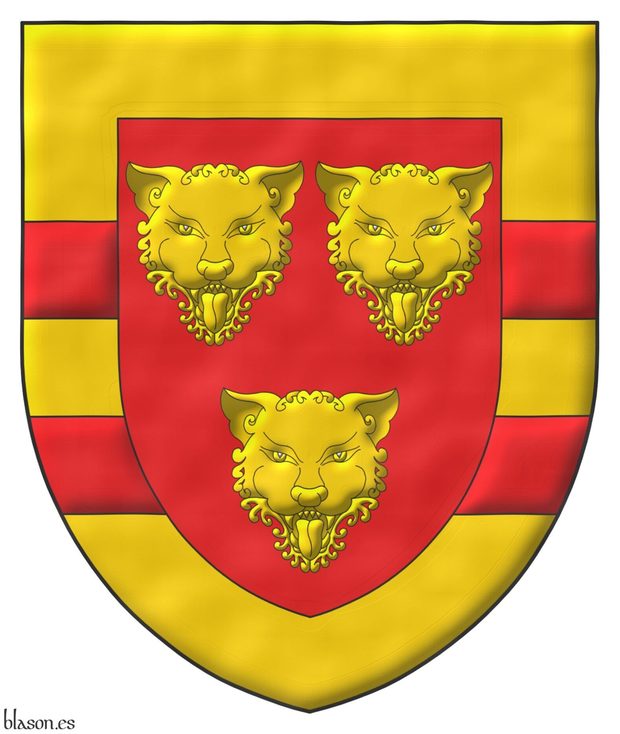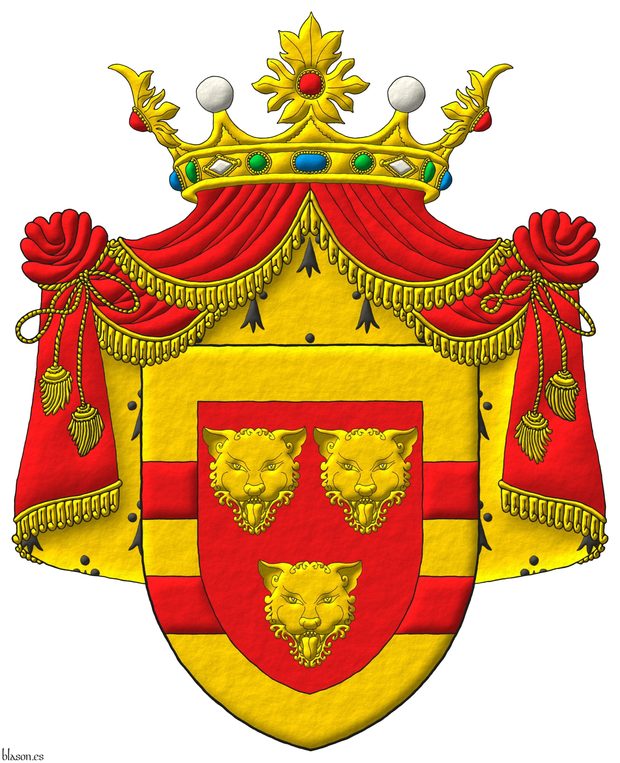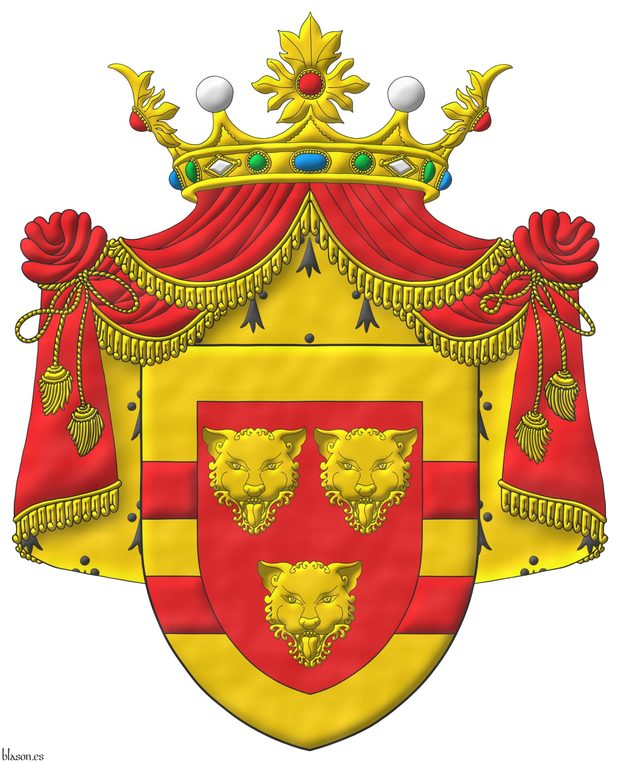
![Ver [Empresa, conjunto de cargas sobre el campo] en criterios utilizados. Unicornio saltante sobre la divisa, criterio.](../css/Unicornio.Criterio.png)
Empresa, conjunto de cargas sobre el campo
En Don Quijote, [Cervantes Saavedra, M. de; 1605; volumen 1, capítulo 18], el escudo de armas del «duque de Nerbia» se describe utilizando la palabra «empresa»~«enterprise», escribiendo «las armas de los veros azules», refiriéndose al forro de su escudo de armas, «es el poderoso duque de Nerbia, Espartafilardo del Bosque, que trae por empresa en el escudo una esparraguera, con una letra en castellano que dice así: «Rastrea mi suerte»».
Unas líneas antes, y para el joven caballero francés Pierres Papín, con un escudo sencillo de plata sin cargas ni lema, Cervantes escribe sin «empresa»: «que trae las armas como nieve blancas y el escudo blanco y sin empresa alguna».
Cervantes utiliza «empresa» para referirse únicamente a las cargas del escudo de armas, no al campo, ni a su color, metal o forro, ni al lema, lo cual queda claro cuando escribe: «Y desta manera fue nombrando muchos caballeros del uno y del otro escuadrón que él se imaginaba, y a todos les dio sus armas, colores, empresas y motes...».
El término se utiliza con el mismo significado de «carga en el escudo de armas» en el comentario al final de [Febrer, J.; Siglo XIII; trova 39] que dice «y quiso significarle con el puente, que traía por empresa en su escudo», siendo en este caso la carga el puente.
La quinta acepción del término «empresa» en el diccionario [Real Academia Española; 2014] es «Símbolo o figura que alude a lo que se intenta conseguir o denota alguna cualidad de la que se hace alarde, acompañada frecuentemente de un lema», que si bien no se refiere específicamente a la heráldica, está en línea con el uso anterior y deja claro que el lema no es parte de la «empresa» aunque puede acompañarla.
Por tanto, en castellano, el término «empresa» se refiere específicamente a la carga o cargas sobre el campo de un escudo de armas, y no incluye los esmaltes del campo, el lema, ni sus ornamentos exteriores.
Category: Criterion.


![Ver [Enterprise, set of charges on the field] en criterios utilizados. Unicornio saltante sobre la divisa, criterio.](../css/Unicornio.Criterio.png)
Enterprise, set of charges on the field
In Don Quixote, [Cervantes Saavedra, M. de; 1605; volume 1, chapter 18], the coat of arms of the «duke of Nerbia» is described using the word «empresa»~«enterprise», writing «las armas de los veros azules», referring to the fur on his coat of arms, «es el poderoso duque de Nerbia, Espartafilardo del Bosque, que trae por empresa en el escudo una esparraguera, con una letra en castellano que dice así: «Rastrea mi suerte»» ~ «the blue vair arms, is the powerful duke of Nerbia, Espartafilardo del Bosque, who bears as a charge on his shield an asparagus plant, with an inscription in Castilian that says: «Tracks my fate»».
A few lines before, and for the young French knight Pierres Papín, with simple arms Argent without charges or motto, Cervantes writes without «empresa»: «que trae las armas como nieve blancas y el escudo blanco y sin empresa alguna» ~ «who bears arms as white as snow and a shield white and without any charges».
Cervantes uses «empresa» to mean only the charges on the coat of arms, not the field, nor its color, metal or fur, nor the motto, which is clear when he writes: «Y desta manera fue nombrando muchos caballeros del uno y del otro escuadrón que él se imaginaba, y a todos les dio sus armas, colores, empresas y motes...» ~ «And in this way, he went on naming many knights from one and the other squadron that he imagined, and to each of them, he gave arms, colors, charges, and mottos...».
The term is used with the same meaning of «charge on the coar of arms» in the commentary at the end of [Febrer, J.; Siglo XIII; trova 39] which says «y quiso significarle con el puente, que traía por empresa en su escudo» ~ «and wanted to signify with the bridge that he bore as a charge on his shield», where in this case, the charge is the bridge.
The fifth definition of the term «empresa» in the dictionary [Real Academia Española; 2014] is «Símbolo o figura que alude a lo que se intenta conseguir o denota alguna cualidad de la que se hace alarde, acompañada frecuentemente de un lema» ~ «Symbol or figure that alludes to what one intends to achieve or denotes a quality of which one boasts, often accompanied by a motto», which, while not specific to heraldry, aligns with the previous usage and makes it clear that the motto is not part of the «empresa» though it may accompany it.
Then, in Castilian, the term «empresa» refers specifically to the charge or charges on the field of a coat of arms, and it does not include the field tinctures, the motto, or its external ornaments.
Category: Criterion.


![Ver [Gourdon de Genouillac, H.; 1889] en referencias bibliográficas. Libro abierto, hojas de plata, filo de oro, guardas de gules, tapas de sable.](../css/Libro.Bibliografia.png)
Gourdon de Genouillac, H.; 1889
Henri Gourdon de Genouillac, «L'Art Héraldique», part of the series Bibliothèque de l'enseignement des Beaux-arts, published under the direction of M. Jules Comte, Maison Quantin, 290 pages, 21 centimeters, Paris, 1889.
With some black and white small illustrations, it covers the art of heraldry, its history, rules, and applications, and serves as a comprehensive guide for artists, historians, and those interested in the heraldic art.
Contents
- Chapter I. The blazon - Pieces and figures that compose coats of arms, page 11.
- Chapter II. Repertoire of attributes, page 98.
- Chapter III. External ornaments of the shield, their use, and their misuse, page 145.
- Chapter IV. Municipal arms, page 188.
- Chapter V. The blazon in the arts, page 200.
- Chapter VI. Blazoned garments, page 207.
- Chapter VII. Seals, tokens, méreaux of corporations, communities, page 214.
- Chapter VIII. The fleur-de-lis, the eagle, the lion, the leopard, various figures, page 222.
- Chapter IX. The blazon in England, Germany, and other nations, page 230.
- Chapter X. Explanatory glossary, page 252.
- Chapter XI. Heraldic bibliography, page 275.
Bibliographical reference of century XIX.
Classification: French language and In black and white.
Author: Gourdon de Genouillac, Henri.
The following article cites this bibliographic reference:
External resource:
Internal resources: GourdonDeGenouillacH1889.LArtHeraldique.pdf PDF version..


![Ver [Toral y Fernández de Peñaranda, E.; 1970] en referencias bibliográficas. Libro abierto, hojas de plata, filo de oro, guardas de gules, tapas de sable.](../css/Libro.Bibliografia.png)
Toral y Fernández de Peñaranda, E.; 1970
Enrique de Toral y Fernández de Peñaranda, «The Coat of Arms of the City of Úbeda: Notes for a Historical Study», Boletín del Instituto de Estudios Giennenses, pages 33-38 plus 10 illustrations, total 22 pages, number 66, ISSN 0561-3590, Jaen, 1970.
Bibliographical reference of century XX.
Classification: Article, Castilian language and In black and white.
Author: Toral y Fernández de Peñaranda, Enrique.
Internal resources: Provincial Council of Jaén https://www.dipujaen.es/boletinieg/pdf.raw?query=id:0000443974&page=38&lang=es&view=bieg and Rioja University https://dialnet.unirioja.es/descarga/articulo/2070193.pdf.


Juchter van Bergen Quast, Rudolph Andries Ulrich

Gules, three Leopards faces Or, the whole within a Border Or with two Bars Gules.
Escudo de gules, tres cabezas de leopardo de oro; una bordura de oro con dos burelas de gules.
Interpreted coat of arms: with a pointed shape; illuminated with metal or and color gules; outlined with sable; and a freehand finish.
Blazon keywords: Gules, Three, Head, Leopard, Or, Ordered, Bordure, Two and Bar.
Style keywords: Freehand, Pointed, Illuminated and Outlined in sable.
Classification: Coat of arms, Interpreted and Personal.
Bearer: Juchter van Bergen Quast, Rudolph Andries Ulrich.


Rudolph Andries Ulrich Juchter van Bergen Quast

Gules, three Leopards faces Or, the whole within a Border Or with two Bars Gules.
Watercolor finishing
Blazon keywords: Gules, Three, Head, Leopard, Or, Ordered, Bordure, Two and Bar.
Style keywords: Watercolor, Pointed, Illuminated and Outlined in sable.
Classification: Coat of arms, Interpreted and Personal.
Bearer: Juchter van Bergen Quast, Rudolph Andries Ulrich.


Rudolph Andries Ulrich Juchter van Bergen Quast, crown and mantle

Gules, three Leopards faces Or, the whole within a Border Or with two Bars Gules. Crest: A crest coronet proper. Mantle: Gules doubled Erminois.
Freehand finishing
Blazon keywords: Gules, Three, Head, Leopard, Or, Ordered, Bordure, Two, Bar, Crest and mantling, Crown of Prince, Crown, Open, Mantle, Erminois and Sable.
Style keywords: Freehand, Pointed, Illuminated and Outlined in sable.
Classification: Coat of arms, Interpreted and Personal.
Bearer: Juchter van Bergen Quast, Rudolph Andries Ulrich.


Rudolph Andries Ulrich Juchter van Bergen Quast, blazon and blason

Gules, three Leopards faces Or, the whole within a Border Or with two Bars Gules. Crest: A crest coronet proper. Mantle: Gules doubled Erminois.
Escudo de gules, tres cabezas de leopardo de oro; una bordura de oro con dos burelas de gules. Timbrado de una corona de príncipe abierta y manto de gules y forro armiñado de oro y sable.
Watercolor finishing
Blazon keywords: Gules, Three, Head, Leopard, Or, Ordered, Bordure, Two, Bar, Crest and mantling, Crown of Prince, Crown, Open, Mantle, Erminois and Sable.
Style keywords: Watercolor, Pointed, Illuminated and Outlined in sable.
Classification: Coat of arms, Interpreted and Personal.
Bearer: Juchter van Bergen Quast, Rudolph Andries Ulrich.

Continue with: Rudolph Andries Ulrich Juchter van Bergen Quast, badge.
-
Language
-
Categories of heraldry
-
Divisions of the field
- Without divisions
- Party per pale
- Party per fess
- Party per bend
- Party per bend sinister
- Tierce
- Tierce sinister
- Tierced per pale
- Tierced per fess
- Tierced per bend
- Tierced pallwise inverted
- Quarterly
- Quarterly per saltire
- Gyronny
- Party per fess, the chief per pale
- Party per pale, the sinister per fess
- Party per fess, the base per pale
- Party per pale, the dexter per fess
- Chapé
- Chaussé
- Embrassé
- Contre-embrassé
- Party per chevron
- Enté
- Enté en point
- Flanched
-
Metals
-
Colours
-
Furs
-
Other tinctures
-
Ordinaries and sub-ordinaries
-
Diminutives of the ordinaries
-
Geometric charges
-
Composite ordinaries
-
Inanimate charges from Nature
Atom, Crescent, Diamond, Emerald, Estoile, Increscent, Lightning flash, Moon, Mount, Mullet, Mullet of four points, Orbital, Plough of Ursa Major, Rainbow, Ray of the sun, River, Sea, Snowflake, Sun, Sun in splendour, Sun of May, Trimount, Water and Wave.
-
Vegetal charges from Nature
Acorn, Apple, Apple tree, Ash, Bluebonnet, Camellia, Chrysanthemum, Cinquefoil, Cornflower, Dogwood flower, Double rose, Elm, Fleur de lis, Flower, Gourd, Holm oak, Hop cone, Kapok tree, Laurel, Lily, Linden, Lotus flower, Madonna lily, Mexican cedar tree, Oak, Olive tree, Palm tree, Plantain plant, Pomegranate, Poplar leaf, Rose, Shamrock, Sunflower, Thistle, Tree, Tulip, Vine and Wheat.
-
Animal charges from Nature
Badger, Bald eagle, Barbel, Barn owl, Bear, Beaver, Beetle, Bighorn sheep, Blackbird, Boar, Brach hound, Bull, Doe, Dog, Dolphin, Dove, Eagle, Elephant, Falcon, Female figure, Fish, Flame, Fly, Fox, Frog, Goat, Goldfinch, Goose, Heron, Horse, Hummingbird, Jaguar, Lark, Leopard, Lion, Lion passant, Lion rampant guardant, Lioness, Lynx, Male figure, Martlet, Merino ram, Owl, Panther, Parrot, Peacock, Pelican, Pelican in her piety, Puffin, Quetzal, Raven, Roe deer, Rooster, Savage, Seagull, Serpent, She-wolf, Stag, Starling, Talbot, Tyger, Vulture, Warren hound and Wolf.
-
Parts of natural charges
Arm, Beak, Branch, Caboshed, Chest, Claw, Covert, Dorsal fin, Eagle claw, Ermine spot, Escallop, Feather, Foot (palmiped), Foreleg, Forepaw, Hand, Head, Heart, Hoof, Leaf, Neck, Ostrich feather, Palm frond, Paw, Roe deers' attires, Shoulder, Sprig, Stags' attires, Stem, Swallow-tail, Tail, Tail addorsed, Tail fin, Talon, Tooth, Trunk, Trunk (elephant), Two hands clasped, Two wings in vol, Udder, Wheat spike, Wing and Wrist.
-
Artificial charges
Ace of spades, Anchor, Anvil, Arch, Arm vambraced, Armillary sphere, Arrow, Axe, Bell, Bell tower, Beret, Bonfire, Book, Bookmark, Bow, Branding iron, Bridge, Broken, Buckle, Cannon, Cannon dismounted, Cannon port, Canopy roof, Carbuncle, Castle, Celtic Trinity knot, Chain, Chess rooks, Church, Clarion, Clay pot, Closed book, Club, Column, Comb, Compass rose, Conductor's baton, Cord, Covered cup, Crozier, Crucible, Cuffed, Cup, Cyclamor, Dagger, Double vajra, Drum, Ecclesiastical cap, Fanon, Federschwert, Fleam, Four crescents joined millsailwise, Galician granary, Garb, Gauntlet, Geometric solid, Grenade, Halberd, Hammer, Harp, Host, Hourglass, Key, Key ward, Knight, Knot, Lantern, Letter, Line, Loincloth, Menorah, Millrind, Millstone, Millwheel, Monstrance, Mortar, Mullet of six points pierced, Nail, Non-classic artifact, Norman ship, Number, Oar, Oil lamp, Open book, Page, Pair of scales, Parchment, Pestle, Piano, Pilgrim's staff, Plough share, Polish winged hussar, Port, Portcullis, Potent, Quill, Ribbon, Rosette of acanthus leaves, Sabre, Sackbut, Sail, Scroll, Scythe, Sheaf of tobacco, Ship, Skirt, Spear, Spear's head, Stairway, Star of David, Step, Sword, Symbol, Tetrahedron, Torch, Tower, Trident, Trumpet, Turret, Two-handed sword, Wagon-wheel, Water-bouget, Wheel, Winnowing fan and With a turret.
-
Immaterial charges
Angel, Archangel, Basilisk, Dragon, Dragon's head, Garuda, Golden fleece, Griffin, Heart enflamed, Justice, Mermaid, Our Lady of Mercy, Ouroboros, Paschal lamb, Pegasus, Phoenix, Sacred Heart of Jesus, Saint George, Sea-griffin, Trinity, Triton, Unicorn, Winged hand and Wyvern.
-
External elements
-
Heraldic creations
-
References
-
Formats
-
Keywords on this page
Open, Watercolor, Pointed, Erminois, Article, Barbed, Bibliography, Bordure, Seeded, Bar, Head, Pean, Crown, Crown of Prince, Cotised, Criterion, Tusked, Outlined in sable, Two, Elephant, In bend sinister, In black and white, Coat of arms, Male figure, Personal, Gules, Illuminated, Badge, Interpreted, Juchter van Bergen Quast, Rudolph Andries Ulrich, Castilian language, French language, Leopard, Hand, Mantle, Ordered, Or, Oval, Statant, Rose, Sable, Century XIX, Century XX, Sinister, Vert, Crest and mantling, Freehand and Three.
